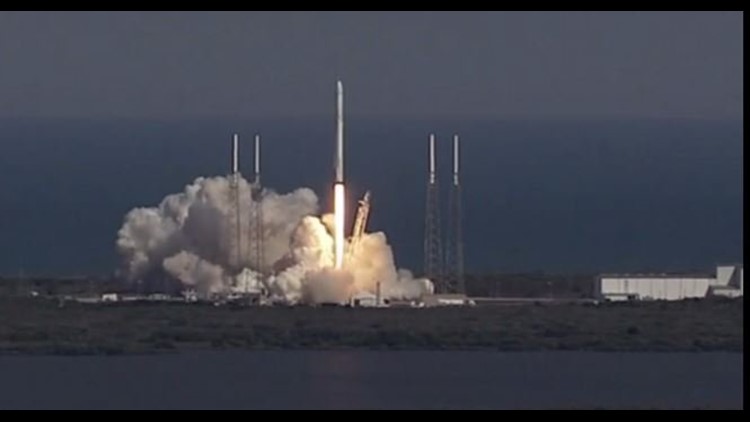CAPE CANAVERAL, Fla. – It was a double win for SpaceX Friday – not only did a first-stage booster rocket finally land safely on an ocean platform, but the company also successfully launched an inflatable room for NASA astronauts, the first of its kind.
SpaceX employees watched from Mission Control in Hawthorne, California, and burst into wild applause as many jumped up and down cheering, “U.S.A., U.S.A.”
It was a moment of ecstasy for Elon Musk’s company after five other rockets failed spectacularly. In a similar attempt on June 28, the craft broke apart minutes after taking off, destroying the cargo.
Here are some of SpaceX’s past attempts:
F9R-Dev test flight explodes on August 2014:
Barge landing fail in the Atlantic in January, 2015:
Ocean landing goes awry in April 2015:
Rocket disintegrates immediately after launch in June, 2015:
Rocket topples over after landing, bursting into flames January, 2016:
SpaceX launched a Falcon 9 rocket on Friday afternoon from Cape Canaveral Air Force Station in Florida, sending the Dragon cargo capsule to the International Space Station.
The Dragon was packed with about 7,000 pounds of supplies, experiments and hardware for the ISS. Other cargo, such as mice to test muscle atrophy and bone loss in space, was packed right before the launch.
This was the first attempt by SpaceX to launch a Falcon 9 rocket for a resupply mission since June 2015, when the company’s rocket broke apart minutes after liftoff. The Dragon, a free-flying spacecraft designed to deliver cargo and eventually humans into orbit, was destroyed in the explosion. SpaceX plans to launch its first human crew in 2017.
Friday’s launch was the eighth mission by SpaceX under NASA’s Commercial Resupply Services contract. Similar to previous launches, SpaceX will attempt to land part of its rocket on a floating barge in the Atlantic Ocean.
Testing the expandable habitat
Although there are no humans heading to space with this launch, what’s exciting is the cargo.
The Dragon spacecraft will carry an expandable habitat to the space station. The habitat, called the Bigelow Expandable Activity Module or BEAM, is a prototype that will attach to the ISS and expand to the size of a small bedroom, according to NASA’s Rajib Dasgupta, who worked on BEAM and spoke during a teleconference last week.
“These ‘expandables’ take up less room on a rocket, but once set up, provide greatly enhanced space for living and working,” NASA said.
The habitat, which was built by Bigelow Aerospace, will increase in size to 13 feet long and 10.5 feet in diameter. It will be big enough for a crew member to enter. However, no one will live in the compartment. Instead, four times a year an astronaut will enter it and conduct a few hours’ worth of tests to see how the prototype fares in microgravity, analyzing radiation, pressure, temperature and the general status and structure of the habitat. BEAM will be installed on the space station for two years.
“One of the benefits of an expandable habitat is that it offers protection from space debris like microasteroids,” Bigelow Aerospace’s Mike Gold said.
Gold said the durability of the habitat is partly due to a Kevlar-like weave that runs throughout the structure. “I like to ask people, would you rather be protected from a gunshot with aluminum or Kevlar? Chances are people will say a Kevlar vest,” he said, commenting on how the structure will protect against small space debris. This debris has the potential to travel quickly through space and cause serious damage.
Next steps for space travel?
If BEAM passes NASA’s tests, it could be a huge step for Bigelow Aerospace. Company founder and CEO Robert Bigelow, who made his fortune from the hotel chain Budget Suites, hopes the habitat’s technology could someday be used for research and tourism trips to other planets in the solar system.
“The next step is looking into a private sector space station in lower orbit,” Gold said. “NASA has made clear that there won’t be another government space station after ISS.”
NASA said if the habitat performs favorably, the technology could lead to future development that will aid in deep space travel, such as getting astronauts to Mars and beyond.
The Dragon spacecraft is due to arrive at the space station on Sunday. NASA astronaut Jeff Williams and European Space Agency astronaut Tim Peake will use the station’s robotic arms to catch the spacecraft.
The spacecraft will return to Earth in May, bringing back biological samples from astronauts. This includes samples collected during NASA’s one-year mission, in which now-retired American astronaut Scott Kelly spent 340 days in space.



